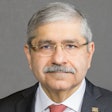The convenience of pharmacologic stress agents and an increase in patient mobility issues are contributing to a decades-long decline in the use of exercise stress for SPECT myocardial perfusion imaging (MPI), according to a study presented at the American Society of Nuclear Cardiology (ASNC) annual meeting.
A review of patients at Hartford Hospital in Connecticut and Mount Sinai Medical Center in New York found that use of exercise stress declined by approximately 10% from 1996 to 2012, while pharmacologic stress tests increased by nearly 10% during the same period. Interestingly, there was also a decrease in abnormal SPECT MPI results, despite a greater number of patients with cardiac risk factors and comorbidity.
The use of exercise stress appears to be declining due to a general societal trend of individuals becoming more sedentary and less able to exercise, as well as the overall ease of using pharmacologic stressors, according to study co-author Dr. Gurukripa Kowlgi of Hartford Hospital, who presented the results on September 19 at the ASNC meeting.
"Also, there are people who we think can exercise, but there is a lower threshold of giving them the agent and converting them to pharmacologic testing," he said.
The rise of pharmacologic stressors
Exercise stress SPECT MPI has long been the preferred way to assess cardiac function when the heart is working its hardest. Today, however, pharmacologic stress agents can recreate the same physiological effects for a mobility-challenged patient, stressing the heart as if he or she were on a treadmill or bicycle.
As a result, many imaging centers throughout the U.S. are taking advantage of pharmacologic agents to evaluate more patients with cardiac risk factors that could lead to severe heart problems.
The growing use of pharmacologic stressors was documented in a study published last year by researchers from St. Luke's-Roosevelt (part of the Mount Sinai Health System). The study found that the number of pharmacologic stress tests rose between 1991 and 2009, but the research did not explore specific reasons for the increase (Rozanski et al, Journal of the American College of Cardiology, March 12, 2013, Vol. 61:10, pp. 1054-1065).
"So we wanted to confirm the same trend and investigate why this is happening," Kowlgi said.
Cardiac risk factors
Kowlgi's team included a total of 76,385 patients from Hartford and Mount Sinai. From 1996 to 2012, exercise SPECT MPI was performed on 33,373 patients (43.7%), while 43,012 patients (56.3%) received pharmacologic stress. Of the total group, 8,087 patients (10.6%) received both exercise and pharmacologic SPECT MPI.
The mean age of the group who received exercise SPECT MPI increased from 57.8 years (± 12.2 years) in 1996 to 60.5 years (± 11.7 years) in 2012. Meanwhile, the mean age of the pharmacologic stress group dropped from 66.8 years (± 12.2 years) in 1996 to 65.8 years (± 13.2 years) in 2012.
The mean body mass index (BMI) remained relatively constant among the exercise stress (28-29 kg/m2) and pharmacologic stress (29-30 kg/m2) subjects from 1996 to 2012; therefore, increasing obesity did not seem to be a cause for more pharmacologic stress tests, according to the researchers.
The pharmacologic stress group was older and had a greater prevalence of cardiac disease and related risk factors than the group who received exercise stress tests. (Risk factors also increased in the exercise stress group, but not to the same degree as in the pharmacologic stress patients.)
Kowlgi and colleagues also examined certain prevalent cardiac risk factors among the patients, such as hypertension, diabetes, and hyperlipidemia. They found that a steadily increasing number of patients have developed these risk factors and comorbidity.
Overall, the use of exercise stress declined from 49.6% of procedures in 1996 to 39.3% in 2012, while pharmacologic stress tests increased from 50.4% of studies to 60.7% during the same period.
| Trends in SPECT MPI use, 1996-2012 | |||
| Scan type | 1996 | 2005 | 2012 |
| No. of exercise MPI scans | 742 | 3,244 | 2,464 |
| Exercise scans as % of total | 49.6% | 42.8% | 39.3% |
| No. of pharmacologic MPI scans | 755 | 4,343 | 3,799 |
| Pharmacologic scans as % of total | 50.4% | 57.2% | 60.7% |
The results also mirrored those from Rozanski et al in that the number of abnormal stress SPECT MPI exams decreased; Kowlgi offered a couple of hypotheses for the decline.
"We feel that while the whole disease cohort is going up, they are better managed," he said. "For example, someone who has hypertension has their blood pressure controlled for the most part [today] compared to 1996. It's the same for diabetes and hyperlipidemia. That is an avenue for future study to look at all these parameters."
Another possibility is that more patients with mild cardiac issues "may be referred for testing earlier in the care process, which could be another reason for fewer abnormal results," he said.
The researchers plan to continue their work in this regard, using the accumulated data to further analyze cardiac risk factors such as blood pressure and cholesterol to explain the abnormal stress test results.



















